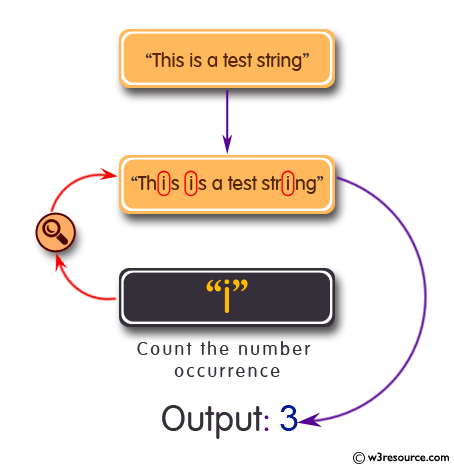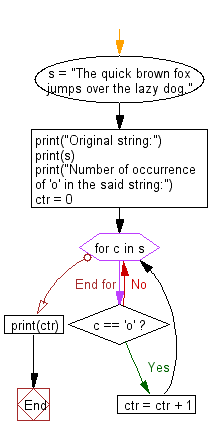Python: Count the number of occurrence of a specific character in a string
Python Basic: Exercise-84 with Solution
Write a Python program to count the number of occurrence of a specific character in a string.
Pictorial Presentation:

Sample Solution:
Using count() function:
Python Code:
s = "The quick brown fox jumps over the lazy dog."
print("Original string:")
print(s)
print("Number of occurrence of 'o' in the said string:")
print(s.count("o"))
Sample Output:
Original string: The quick brown fox jumps over the lazy dog. Number of occurrence of 'o' in the said string: 4
Visualize Python code execution:
The following tool visualize what the computer is doing step-by-step as it executes the said program:
Using loop:
Python Code:
s = "The quick brown fox jumps over the lazy dog."
print("Original string:")
print(s)
print("Number of occurrence of 'o' in the said string:")
ctr = 0
for c in s:
if c == 'o':
ctr = ctr + 1
print(ctr)
Sample Output:
Original string: The quick brown fox jumps over the lazy dog. Number of occurrence of 'o' in the said string: 4
Flowchart:

Visualize Python code execution:
The following tool visualize what the computer is doing step-by-step as it executes the said program:
Using collections.Counter():
Python Code:
from collections import Counter
s = "The quick brown fox jumps over the lazy dog."
print("Original string:")
print(s)
print("Number of occurrence of 'o' in the said string:")
ctr = Counter(s)
print (str(ctr['o']))
Sample Output:
Original string: The quick brown fox jumps over the lazy dog. Number of occurrence of 'o' in the said string: 4
Visualize Python code execution:
The following tool visualize what the computer is doing step-by-step as it executes the said program:
Using Lambda functions:
Python Code:
s = "The quick brown fox jumps over the lazy dog."
print("Original string:")
print(s)
print("Number of occurrence of 'o' in the said string:")
ctr = sum(map(lambda x : 1 if 'o' in x else 0, s))
print(ctr)
Sample Output:
Original string: The quick brown fox jumps over the lazy dog. Number of occurrence of 'o' in the said string: 4
Visualize Python code execution:
The following tool visualize what the computer is doing step-by-step as it executes the said program:
Using Regular Expressions:
Python Code:
import re
s = "The quick brown fox jumps over the lazy dog."
print("Original string:")
print(s)
print("Number of occurrence of 'o' in the said string:")
ctr = len(re.findall("o", s))
print(ctr)
Sample Output:
Original string: The quick brown fox jumps over the lazy dog. Number of occurrence of 'o' in the said string: 4
Visualize Python code execution:
The following tool visualize what the computer is doing step-by-step as it executes the said program:
Python Code Editor:
Have another way to solve this solution? Contribute your code (and comments) through Disqus.
Previous: Write a Python program to test if a certain number is greater than all numbers of a list.
Next: Write a Python program to check if a file path is a file or a directory.
What is the difficulty level of this exercise?
Test your Programming skills with w3resource's quiz.
Python: Tips of the Day
Find current directory and file's directory:
To get the full path to the directory a Python file is contained in, write this in that file:
import os dir_path = os.path.dirname(os.path.realpath(__file__))
(Note that the incantation above won't work if you've already used os.chdir() to change your current working directory, since the value of the __file__ constant is relative to the current working directory and is not changed by an os.chdir() call.)
To get the current working directory use
import os cwd = os.getcwd()
Documentation references for the modules, constants and functions used above:
- The os and os.path modules.
- The __file__ constant
- os.path.realpath(path) (returns "the canonical path of the specified filename, eliminating any symbolic links encountered in the path")
- os.path.dirname(path) (returns "the directory name of pathname path")
- os.getcwd() (returns "a string representing the current working directory")
- os.chdir(path) ("change the current working directory to path")
Ref: https://bit.ly/3fy0R6m
- New Content published on w3resource:
- HTML-CSS Practical: Exercises, Practice, Solution
- Java Regular Expression: Exercises, Practice, Solution
- Scala Programming Exercises, Practice, Solution
- Python Itertools exercises
- Python Numpy exercises
- Python GeoPy Package exercises
- Python Pandas exercises
- Python nltk exercises
- Python BeautifulSoup exercises
- Form Template
- Composer - PHP Package Manager
- PHPUnit - PHP Testing
- Laravel - PHP Framework
- Angular - JavaScript Framework
- Vue - JavaScript Framework
- Jest - JavaScript Testing Framework
